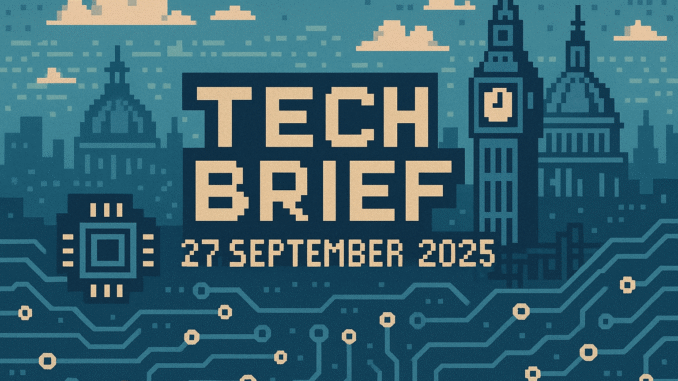
Tech Brief 27 September 2025 lands with a burst of big numbers, old anxieties, and the question of whether Essex is ready for its moment in the digital sun. If you came looking for comfort, or just want a clear view of the latest in British tech, you’re exactly where you need to be.
Missed yesterday’s Tech Brief? Catch up here before diving in.
UK Secures £31 Billion Investment for AI Supercomputing Infrastructure
Bold promises just became bank transfers on UK soil this week, as government ministers unveiled a £31 billion “Tech Prosperity Deal” to catapult British AI capacity into global contention. The deal ropes in Microsoft, Google, OpenAI, and NVIDIA, with Microsoft alone ploughing in £22 billion to build the nation’s largest AI supercomputer in Essex.
A Downing Street press event played up the regional angle: hubs in the North East, Oxford, and Manchester are set to play starring roles, supposedly breathing new life into the national digital ecosystem. If you’ve seen similar booms fizzle before (the Alvey projects, anyone?), you may be holding off your applause. This time, the numbers are higher, and the stakes include actual silicon, not just software jobs. Early reactions from industry forums suggest hope, but also a healthy layer of British scepticism.
Who benefits? In theory, everyone. But regular users and small devs may want to see some real-world kit before writing fan letters to Essex. The next twelve months will show if this is infrastructure with local heart or just clouds drifting in from across the Atlantic.
Microsoft Pledges £22 Billion to Build AI Supercomputer in Essex
“Are we about to become the centre of the universe?” That’s how a grinning Essex councillor summed up the regional mood. Microsoft’s commitment to plant a colossus of computing power at the edge of Greater London means the county will soon play host to racks of advanced hardware, cooled and cabled for machine learning service.
The machine, once complete, is projected to deliver more raw throughput than any previous UK system. Microsoft’s brief mentions “petaflops” (one quadrillion calculations a second), yet doesn’t clarify who gets first run at the cycles. For locals, it means job opportunities, infrastructure upgrades, and a sudden surge in regional pride, even if the first “AI growth zone” billboards feel like something out of a 1995 tech expo.
No reference yet to whether tinkering clubs, hobbyist groups, or schools will see direct benefit. If past funding cycles taught us anything, it’s that impact isn’t always measured on a conference screen. It happens in crowded rooms, the screech of dot matrix printers, and busy soldering benches.
NVIDIA and OpenAI Target UK Startups with £2 Billion and New Support Initiatives
A straight fact: NVIDIA has promised £2 billion for accelerating the UK’s AI startup scene, signalling trust in cottage-scale innovation as much as Big Industry dreams. The focus is on access: cloud credits, engineering mentorship, and “preferred partner” status for qualifying startups. OpenAI, meanwhile, is bringing a parallel stream of funding and technical guidance. For aspiring founders, it’s a window of opportunity as wide as any in living memory.
This story drops historical context completely this time. Forget the usual comparisons. What matters now is the energy at ground level. Whether these resources reach the people fiddling with AI on battered ThinkPads in rented rooms or only trickle to flashier offices will decide if this is a true grassroots invigoration or another layer in the ongoing cloud rush.
Genuine question: How many breakthrough ideas actually come from boardrooms, anyway?
Security Lessons from the Mitnick Indictment Still Apply
Hacking isn’t what it used to be, but the basics haven’t changed much since around this time in 1996. Kevin Mitnick’s indictment, handed down nearly three decades ago, was a turning point for cybersecurity. He cracked code using charm and knowledge, exploiting loopholes almost invisible to his corporate prey. These were the dawn of dial-up, social engineering attacks, and borrow-your-password phone calls.
Today’s AI-powered phishing edgelords are spiritual heirs of Mitnick’s playbook. Phishing, credential theft, and log wiping are still at the top of any breach report, even as technology supposedly moves forward. The Mitnick case forced companies, British and otherwise, to take actual responsibility for the holes in their front lines. This connects directly to the supercomputing story above. All the infrastructure in the world is little use if your staff’s guard drops for a minute.
Systems get faster, users get trickier, but humans are still the wobbly bit in every security plan. That, at least, hasn’t changed.
From the Wayback Machine
On This Day: 1996 – Kevin Mitnick indicted on 25 hacking charges
Mitnick’s arrest captured global headlines. He exploited passwords, cloned phones, and bypassed weak corporate firewalls, shocking the new digital public. The case reflected a growing sense that digital security required fresh approaches. Vintage magazines warned of password-sharing years earlier, but few listened. Mitnick’s story shaped the rise of ethical hacking and the professionalisation of cybersecurity, both in Britain and abroad.
Today’s Big Question
Are these new billions in AI investment fuelling grassroots creativity or reinforcing old patterns of digital dependence? Tech Brief 27 September 2025 returns, as ever, to the question of who actually benefits when the cloud gets bigger.
Keep your passwords awkward, and never let a supercomputer outshine your micro. Next week: more solder, fewer slogans, same curiosity.
Missed yesterday’s Tech Brief? Catch up here

Leave a Reply